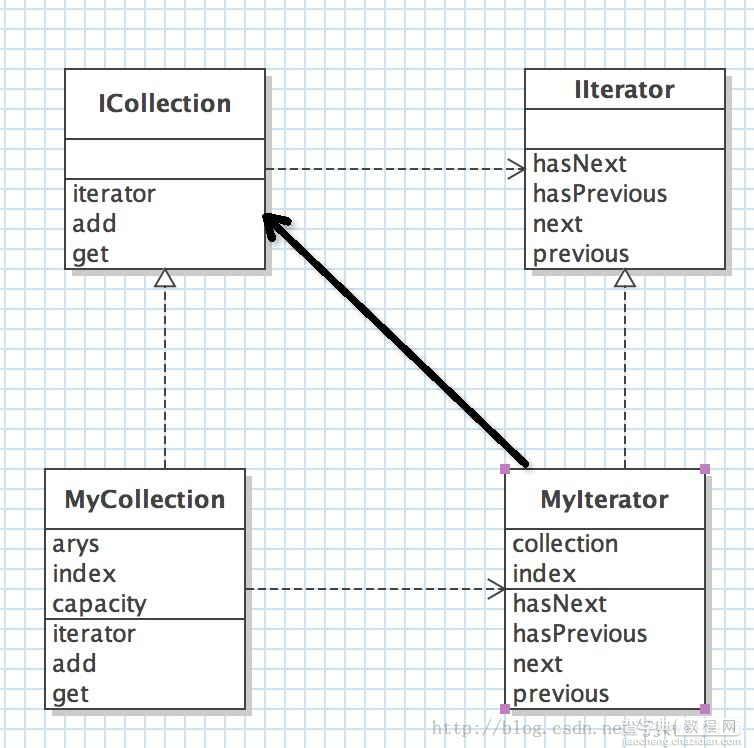迭代器(Iterator)模式,又叫做游标(Cursor)模式。GOF给出的定义为:提供一种方法访问一个容器(container)对象中各个元素,而又不需暴露该对象的内部细节。
迭代器模式由以下角色组成:
迭代器角色(Iterator):迭代器角色负责定义访问和遍历元素的接口。
具体迭代器角色(Concrete Iterator):具体迭代器角色要实现迭代器接口,并要记录遍历中的当前位置。
容器角色(Container):容器角色负责提供创建具体迭代器角色的接口。
具体容器角色(Concrete Container):具体容器角色实现创建具体迭代器角色的接口。这个具体迭代器角色与该容器的结构相关。
Java实现示例
类图:

代码:
/** * 自定义集合接口, 类似java.util.Collection * 用于数据存储 * @author stone * */ public interface ICollection<T> { IIterator<T> iterator(); //返回迭代器 void add(T t); T get(int index); }
/** * 自定义迭代器接口 类似于java.util.Iterator * 用于遍历集合类ICollection的数据 * @author stone * */ public interface IIterator<T> { boolean hasNext(); boolean hasPrevious(); T next(); T previous(); }
/** * 集合类, 依赖于MyIterator * @author stone */ public class MyCollection<T> implements ICollection<T> { private T[] arys; private int index = -1; private int capacity = 5; public MyCollection() { this.arys = (T[]) new Object[capacity]; } @Override public IIterator<T> iterator() { return new MyIterator<T>(this); } @Override public void add(T t) { index++; if (index == capacity) { capacity *= 2; this.arys = Arrays.copyOf(arys, capacity); } this.arys[index] = t; } @Override public T get(int index) { return this.arys[index]; } }
/* * 若有新的存储结构,可new 一个ICollection, 对应的 new 一个IIterator来实现它的遍历 */ @SuppressWarnings({"rawtypes", "unchecked"}) public class Test { public static void main(String[] args) { ICollection<Integer> collection = new MyCollection<Integer>(); add(collection, 3, 5, 8, 12, 3, 3, 5); for (IIterator<Integer> iterator = collection.iterator(); iterator.hasNext();) { System.out.println(iterator.next()); } System.out.println("-------------"); ICollection collection2 = new MyCollection(); add(collection2, "a", "b", "c", 3, 8, 12, 3, 5); for (IIterator iterator = collection2.iterator(); iterator.hasNext();) { System.out.println(iterator.next()); } } static <T> void add(ICollection<T> c, T ...a) { for (T i : a) { c.add(i); } } }
打印:
3 5 8 12 3 3 5 ------------- a b c 3 8 12 3 5
【Java使用设计模式中迭代器模式构建项目的代码结构示例】相关文章:
